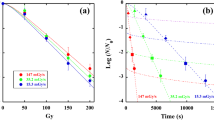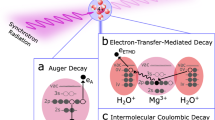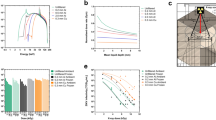Abstract
THE lethal effects of irradiations with X-rays on E. coli have been studied. Our observations were made on bacteria dried, or suspended either in 2 per cent broth or saline solution, at bacterial densities of 10−1 to 10−10 gm./ml. Some experiments were also made by adding 10−3 M cysteine to the solutions. An X-ray tube was used operating at 110 kV., and 4 m.amp., at a dose-rate of 36 r./min., without any additional filter.
This is a preview of subscription content, access via your institution
Access options
Subscribe to this journal
Receive 51 print issues and online access
$199.00 per year
only $3.90 per issue
Buy this article
- Purchase on SpringerLink
- Instant access to full article PDF
Prices may be subject to local taxes which are calculated during checkout
Similar content being viewed by others
References
Lea, D. E., Smith, K. M., Holmes, B., and Markham, R., Parasit., 36, 110 (1944).
Friedewald, W. F., and Anderson, R. S., J. Exp. Med., 74, 463 (1941).
Alper, T., Nature, 169, 183 (1952).
Lea, D. E., “Action of Radiations on Living Cells” (University Press, Cambridge, 1946).
Dale, W. M., Davies, J. V., and Gilbert, C. W., Biochem. J., 45, 93 (1949).
Author information
Authors and Affiliations
Rights and permissions
About this article
Cite this article
BIAGINI, C. Quantitative Aspects of the Indirect Action of X-Radiation at Various Concentrations on E. coli . Nature 172, 868–869 (1953). https://doi.org/10.1038/172868b0
Issue date:
DOI: https://doi.org/10.1038/172868b0
This article is cited by
-
Nervous component in the mechanism of action of radioprotective substances
Bulletin of Experimental Biology and Medicine (1967)



